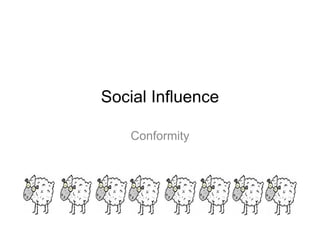
Social influence intro asch & sherif
- 2. What is Social Influence? The way in which a person or group of people affect the attitudes and behaviour of an individual (Brody & Dwyer, 2002)
- 3. What is conformity? The tendency to change what we do (behaviour) or think and say in response to real or imagined group pressure.
- 4. Types of Conformity There are 2 types of conformity… Compliance Superficial and public. Change in behaviour not personal views Internalisation Deep and private. Change in behaviour AND personal views
- 5. Without notes... Without your notes complete your Glossary of Terms for Conformity Social Norms (Implicit & explicit) Compliance Internalisation
- 7. Research demonstrating compliance Compliance – Asch (1951) - Most superficial type of conformity - Individual conforms publically to the group but privately disagrees Line-judgement task - Change in behaviour not personal views
- 9. Asch - A01 Unambiguous line judging task Conducted a pilot study – 3/720 errors 123 American male undergraduates - In each experiment all but one of the group were confederates WHY?! 18 trials in total, 12 were critical - When all confederates gave the same incorrect answer Confederate Confederate Confederate Real p Confederate
- 10. Findings – A01 Mean conformity rate of 37% There were wide individual differences within the results: Participants agreed with the Is 37% low? -5% conformed on every trial incorrect -25% Not remained considering totally independent (majority never answer once agreed with how the obvious majority when they on over 1/3 answered of (incorrectly) unambiguous) the trials the task was!
- 11. Conclusions – A01 Asch’s participants explained that one of the reasons they agreed with the majority on an obviously wrong answer was so as not to stand out from the crowd. Asch concluded therefore that participants’ actions were a clear example of compliance!
- 12. Variations of the experiment Unanimity of stooges (same wrong answer) Unanimous = High level of conformity 1 stooge giving right answer = drops to 5% Ambiguity – how obvious is the wrong answer - As lines become similar in length conformity rises Group size – 1, 2 & 3 stooges 1 stooge = 0%, 2 stooges = 12.8%, 3 stooges = 37% (more than that – no rise)
- 13. Evaluation – A02 You should be able to think of 4 evaluation points without anymore information than the research outline High degree of control over variables Lack of population validity (used only men) Androcentric Lack of ecological validity Ethical issues - lack of informed consent
- 14. Additional Evaluation – A02 Asch’s research was conducted in America during the era of McCarthyism (an era where people were accused, without adequate evidence, of being disloyal to the country and guilty of treason) Why is this a problem for Asch’s research? What type of validity might Asch’s research lack? Lack of Temporal Validity
- 15. Extra empirical evaluation – A02 • Crutchfield (1956) (repeated Asch’s research and found a similar conformity rate) • Eagly & Carli (1981) (women conform more than men in a situation that’s observed but men conform more in an unobserved situation) • Perrin & Spencer (1980) (repeated Asch’s research and found a lower conformity rate)
- 16. Potential questions Outline research into conformity (6 marks) Describe and evaluate research into compliance (12 marks)
- 17. What is Social Influence? The way in which a person or group of people affect the attitudes and behaviour of an individual (Brody & Dwyer, 2002)
- 18. What is conformity? The tendency to change what we do (behaviour) or think and say in response to real or imagined pressure from a group.
- 19. Types of Conformity There are 2 types of conformity… Compliance Superficial and public. Change in behaviour not personal views Internalisation Deep and private. Change in behaviour AND personal views
- 20. Research demonstrating internalisation Internalisation – Sherif (1936) - Deepest level of conformity Autokinetic effect . - Individual conforms both publically and privately to the group - Conversion
- 21. Sherif – A01 Sherif divided participants into 2 groups Aimed to investigate whether participants would conform and change their own individual prediction about how far a spot of Group 1 • Tested individually in a darkened room • Each P made 100 estimates • Put into groups of 2 or 3 • P’s reached a group norm Group 2 • P’s were tested in small groups light moved when the group were no longer there • P’s developed a group estimate • P’s tested individually • P’s estimates reflected the group estimate
- 22. Sherif - findings When put into groups, participants estimates converged towards a central mean Despite not being told to arrive at a group estimate After experiencing group influence, individual estimates reflected the group answers – though in interviews after the experiment participant denied being influence by others
- 23. Sherif - conclusion Sherif suggested that in group 2, participants individual answer reflected the group responses Rohrer et al (1954) replicated Sherif’s study and found that when participants were re-tested individually up to a year later they continued to use the group because the individual participants looking to other group members for information – ambiguous task answer - Showing that p’s had internalised (taken on) the views of the group and privately changed their beliefs.
- 24. Evaluation – A02 You should be able to think of 4 evaluation points without anymore information than the research outline High degree of control over variables Ethical issues – lack of informed consent Lack of ecological validity Ethical issues – use of deception
- 25. Compliance Internalisation Change behaviour not views Public Unambiguous task Not conversion Change behaviour and views Private Ambiguous task True conversion Vs.